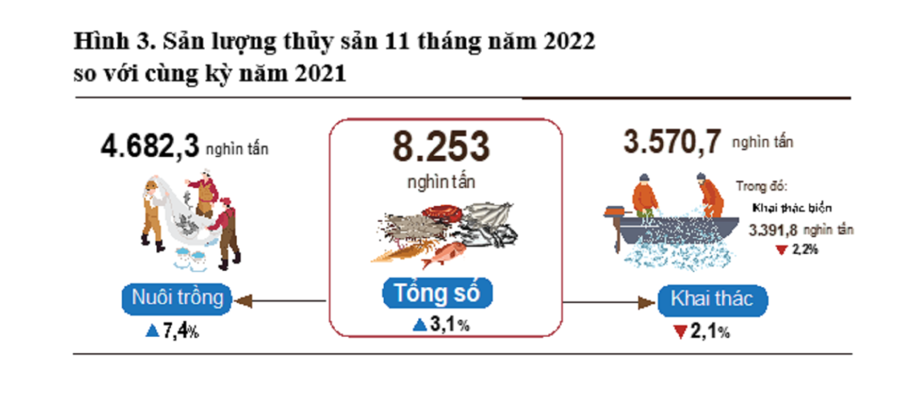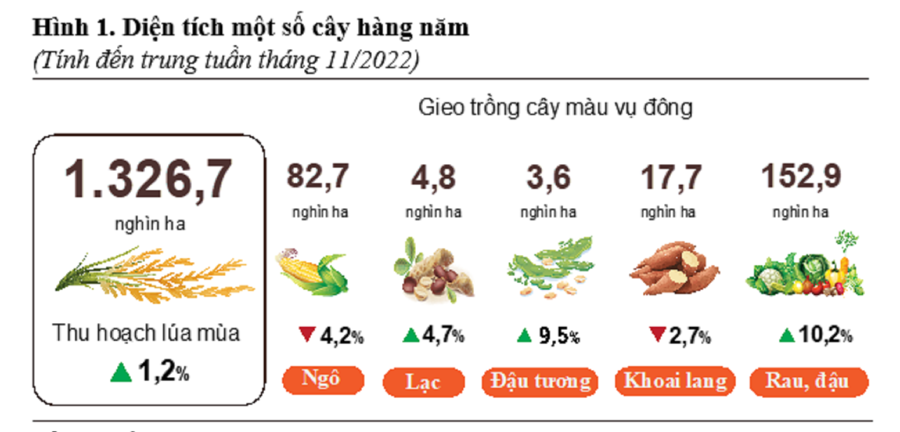[ad_1]
Regarding the fishing industry, the General Bureau of Statistics said that aquaculture has continued to increase in terms of agricultural area and harvested production of important aquatic products to meet the needs of domestic and overseas markets.
Slight increase in fishing output
According to the State Statistical Office SFisheries production in November 2022 was estimated at 802.3 thousand tons, an increase of 3.1% over the same period last year, including: fish reached 577.2 thousand tons, an increase of 3.2%; shrimp reached 115,000 tons, up 3.7%; Other aquatic products reached 110.1 thousand tons, up 2%. Aquaculture production for the month was estimated at 521.6 thousand tons, an increase of 5.1% over the same period last year, of which fish gained 363.5 thousand tons, an increase of 5.5%; Shrimp reached 101.3 thousand tons, up 4.2%.
The harvest of pangasius this month has continued to increase significantly compared to the same period last year due to the reasonable price of pangasius products, which corresponds to the purchasing power of consumers around the world in the context of high inflation. Raw pangasius remained stable at a high level. Pangasius production this month was estimated at 167.8 thousand tons, up 9.2% from the same period last year.
The application of high-tech shrimp farming model, super-intensive shrimp farming has helped increase shrimp production. The production of white leg shrimp in November 2022 was estimated at 70.5 thousand tons, up 5.9% from the same period last year; Black tiger shrimp production reached 23.2 thousand tons, up 0.9%.

Fisheries production in November was estimated at 280.7 thousand tons, down 0.4% from the same period last year, including: fish reached 213.7 thousand tons, down 0.4%; shrimp reached 13.7 thousand tons, which is the same period last year; other aquatic products reached 53.3 thousand tons, down 0.6%. The production of sea fisheries was estimated at 261.8 thousand tons, a decrease of 0.6% over the same period due to high gasoline prices and the lack of fishing workers, which complicates deep-sea fishing.
In general, fisheries production was estimated at 8,253,000 tons in the first 11 months of 2022, an increase of 3.1% compared to the same period last year. Including: fish reached 5,943.9 thousand tons, up 2.6%; shrimp reached 1,124.8 thousand tons, up 7.7%; Other aquatic products reached 1,184.3 thousand tons, up 1.2%
INCREASE IN FOREST TIMBER PRODUCTS
For forestry production, data from the General Bureau of Statistics show that the area of newly planted forests nationwide was estimated at 33.6 thousand hectares in November 2022, up 1.4% from the same period last year; The number of scattered forest trees reached 18.3 million trees, an increase of 6.4%.
In November, fuelwood production reached 1.6 million steres, up 7.9%; Wood production reached 2,019.8 thousand m3, which is an increase of 9%. The production of harvested timber increased sharply during the same period due to the increase in planted forest area reaching harvest age and the increased demand for raw materials for timber processing plants.
Some places have high timber production in the same period: Tuyen Quang reached 132.8 thousand m3, up 71.7%; Thanh Hoa reached 70.9 thousand m3, up 17.2%; Nghe An reached 179.5 thousand m3, up 12%; Quang Ngai reached 276.6 m3, up 11.3%…
In general, the newly planted forest area in 11 months was estimated at 260.6 thousand ha, an increase of 4.9% compared to the same period last year; the number of scattered forest trees reached 96.5 million trees, up 5.3%; Firewood production reached 17 million steres, up 1%; Wood production reached 17.6 million m3, an increase of 6.6%.
The degraded forest area was 58.2 ha in the month, a decrease of 9.6% compared to the same period last year, in which mainly forest was felled and destroyed, with 46.8 ha, an increase of 26.8%; The burnt forest area was 11.4 ha, a decrease of 58.5%. In general, the whole country has 1,047.6 ha of degraded forest in 11 months of 2022, 58.4% less than the same period last year, of which 37.9 ha of burned forest area, 97.5% less; The area deforested and cleared was 1,009.7 ha, a decrease of 1.6%.
LISTEN TO EARLY SUMMER RICE EVERY YEAR
According to the General Bureau of Statistics, as of mid-November 2022, 1,326.7 thousand hectares of winter rice had been harvested nationwide, accounting for 85.4% of the acreage and up 101.2% from the same period last year. Where: the northern provinces harvested 980.4 thousand hectares, accounting for 95.8% and 98.2%; The southern localities harvested 346.3 thousand hectares, which is 65.1% and 111.1%.
Southern places are harvesting winter rice earlier than the same period last year due to favorable weather conditions, places are actively responding to climate change to limit saltwater intrusion, so people are expanding their acreage.
This year’s harvest, despite the large amount of rain, the localities have actively developed scenarios for water regulation; In order to optimally prepare the conditions for flood protection work, to minimize damage from adverse weather conditions, so that crop production achieved good results, the yield increased compared to the previous year.
The yield of the winter rice crop in the northern provinces is estimated at 53.1 quintals/ha, an increase of 0.5 quintals/ha; Production is estimated at 5.43 million tons, equal to last year’s harvest.
Especially in the Red River Delta, the yield is estimated at 57.5 quintals/ha, an increase of 0.3 quintals/ha; Production is estimated at 2.7 million tons, a decrease of 43 thousand tons, as the acreage decreased by 9.6 thousand hectares. In the southern provinces, the yield of summer rice is estimated at 52.4 quintals/ha, an increase of 2.4 quintals/ha compared to last year’s crop; Production is estimated at 2.77 million tons, up 191 thousand tons.
The area planted with fall-winter rice in 2022 in the Mekong Delta is estimated at 648.7 000 hectares, a decrease of 70.6 000 hectares compared to the fall-winter crop of the previous year, due to the production of these Culture is unstable and cannot be proactive. Apart from this, this year’s autumn-winter rice harvest is also affected by high prices of fertilizers and input materials, causing people to limit investment or switch to perennial crops for greater economic efficiency.
As of November 15, 2022, the entire region has harvested 323,000 hectares of fall-winter rice, accounting for 49.8% of the acreage and 99.8% of the same period last year. According to the preliminary report, the whole harvest is estimated at 56 quintals/ha, a decrease of 0.1 quintals/ha compared to last year’s autumn-winter harvest; Due to a decrease in acreage, the total production of the whole crop is estimated at 3.63 million tons, a decrease of 390,000 tons.

As of November 15, 2022, the southern localities mainly in the Mekong Delta had sown 308 100 hectares of early winter spring rice, accounting for 86% of the same period last year. The progress of planting winter-spring rice is slower than the same period last year, as some places set the sowing schedule later to avoid drought and salinity.
Currently, communities in the north have finished harvesting summer rice and are concentrating on using winter crops. In this year’s winter harvest, many places focus on crops with high economic value, carry out intensive farming and improve quality to increase the selling price of products, especially focus on the production of crops, animal feed, around circular economy such as biomass -Maize to realize , soybean.
[ad_2]
Source link

